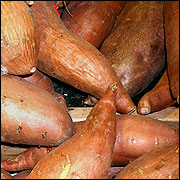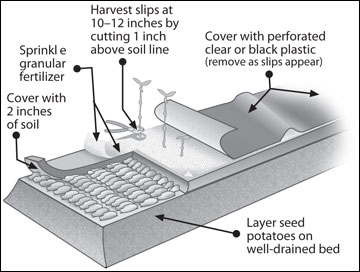
Sweet potatoes are an excellent vegetable crop to include in the field or garden in Missouri. They are high in fiber and in vitamins A and C and low in fat, making them a very nutritious vegetable. Sweet potatoes are often called yams in the United States, but a true yam is a starchy, edible root botanically unrelated to the sweet potato. Locally grown sweet potatoes are becoming a popular produce item at farmers' markets across Missouri.
Transplant production
Sweet potatoes are propagated vegetatively rather than by seeds. That is, seed stock is used to produce slips, or transplants. Slips can be purchased from several suppliers in the Midwest and the southeastern United States, but for larger plantings it may be more economical to purchase seed potatoes and produce your own slips. Always purchase certified or virus-indexed seedstock for slip production. Certified seed will produce the most slips per bushel and have fewer disease problems, and the sweet potatoes will be more uniform in size, shape and quality. The seed potatoes should be bedded when the soil temperature reaches 60 degrees Fahrenheit. One bushel of seed potatoes will produce about 1,000 slips from one cutting or 2,000 from three cuttings. About 20 bushels of seed potatoes will be required to produce enough transplants for one acre.

Presprouting the seed by holding the seed potatoes at 75 to 85 degrees Fahrenheit and 90 percent relative humidity for two to three weeks will increase the number of slips per seed. To minimize rotting in the plant bed, the seed potatoes can be dipped in a fungicide. The plant bed should be located in a well-drained site. Place the potatoes in a single layer 2 to 4 feet wide, and cover the beds with about 2 inches of soil. Do not bury the seed potatoes too deep. Top-dress the bed with a general-purpose, granular fertilizer (for example, 10-10-10), and cover the bed with clear or black plastic. Punch small holes in the plastic to aerate the soil and prevent carbon dioxide and temperature buildup. When the potatoes sprout about an inch, remove the plastic. Row covers can be used to protect the plants in the event of a frost. Sweet potato slips can also be produced using a hotbed or propagation beds within a heated greenhouse.
Slips can be cut from the plant bed when they reach a height of 12 to15 inches (Figure 1). Cut hardy slips 1 inch above the soil line, and plant in the field or garden. Do not pull the slips because this will often transmit root diseases. About three cuttings can be made from the plant bed. Destroy the plant beds after you have harvested all the slips.
Variety selection
Sweet potatoes (Ipomoea batatas Lam.) are warm-season vegetables in the morninglory family. Sweet potatoes thrive in warm weather and are very sensitive to frost.
'Beauregard', 'Hernandez', 'Jewel' and 'Centennial' are suitable varieties for Missouri (Table 1). 'Beauregard' is a high-yielding, disease-resistant variety with a light red skin and a dark, orange flesh. 'Hernandez' and 'Jewel' are copper to brown skinned with dark, orange flesh and perform best in sandy soils. If you desire a white-fleshed sweet potato, consider growing varieties such as 'Nancy Hall', 'White Delite' or 'White Hayman'.
Table 1. Suggested sweet potato varieties for Missouri.
| Sweet potato variety | Days to harvest | Description |
|---|---|---|
| Beauregard | 95 to 100 | Early maturing, light red skin. Excellent shape and yield. Good storage sweet potato. |
| Hernandez | 115 to 120 | Copper skin. Does best in light-textured soils. |
| Jewel | 115 to 120 | Blocky sweet potatoes with copper skin and orange flesh. Very good quality. Does best in light-textured soils. |
Planting and culture
In Missouri, sweet potatoes can be planted in late April (Southern Missouri) through mid to late-May (central and northern Missouri) when soil temperatures are warm and all danger of frost has passed. Plants (slips) are planted three to four nodes deep (3 to 4 inches deep), 9 to 18 inches between plants in rows 36 to 48 inches apart. A node is a bump or swelling on the slip where a leaf was attached. Orientation of the slips is not crucial because slips can be planted upside down and still will produce sweet potatoes. Make sure that there is good soil moisture and use starter fertilizer solution or water after transplanting. The wider the spacing between plants, the faster the sweet potatoes grow or "size up". Sweet potatoes should be planted on ridges or raised beds (6 to 9 inches high). Raised beds aid in root development and improve soil drainage and aeration. Sweet potatoes do not tolerate waterlogged soils. Avoid planting in fields that were previously in sod because this could result in significant white grub and wireworm problems in the sweet potato planting. Soils that are high in organic matter may not produce quality sweet potatoes. Sweet potatoes should be rotated with other vegetable or agronomic crops to prevent pest buildup.
Sweet potatoes can be planted on plastic mulch (for example, black). The mulch will maintain a friable (loose) soil, conserve moisture, suppress weeds and increase soil temperatures. Sweet potatoes grown on plastic mulch will mature faster. Organic mulches such as straw, paper or wood chips can be used to suppress weeds and reduce loss of soil moisture.
Sweet potatoes tolerate acidic soils and the soil pH can be 5.0 to 6.5 for successful growth. Before planting, phosphorus and potassium should be applied based on a soil test. Nitrogen should be applied three weeks after transplanting (11 ounces per 1,000 square feet). An additional side-dress application of 11 to 12 ounces per 1,000 square feet of nitrogen can be applied when the vines begin "running" off the beds. Avoid applying too much nitrogen to sweet potatoes. Excessive nitrogen results in extensive vine growth, but few sweet potatoes.
Sweet potatoes are tolerant of drought, but for maximum yield and quality, 1 inch of water should be applied to the crop each week. Few disease pathogens attack sweet potatoes in Missouri, but insects such as wireworms and white grubs can be a problem.
Weeds should be controlled until the sweet potato vines cover the bed, which occurs about six weeks after transplanting. This can be achieved though cultivation, mulching or herbicides.
Harvest and postharvest handling
Most sweet potato varieties are ready to harvest 95 to 120 days after transplanting. Generally the leaves turn slightly yellow when the sweet potatoes are ready to harvest. Pulling or cutting the vines two to three days before digging will toughen the skins and help reduce skinning of the sweet potatoes. A hill of sweet potatoes will yield about 2 pounds of marketable sweet potatoes and an average yield per acre of 400 bushels (50 pounds) is attainable. Sweet potatoes should be harvested before the first frost in the fall. Frost will kill the vines but should not damage the sweet potatoes.
Sweet potatoes can be harvested by various methods. For large-scale production, a riding harvester is used to dig one or two rows at once. For smaller scale growers, a chain-driven, one-row harvester is commonly used. A turn plow will also be effective in dislodging the sweet potatoes in light-textured soils. If the sweet potatoes are in heavy soils that are dry at harvest, a light irrigation of the soil before digging will reduce skinning. Sweet potatoes should be handled as little as possible to prevent bruising and skinning. When handling sweet potatoes, workers should use cotton gloves to reduce skinning. Sweet potatoes are often packaged in slatted, bushel crates holding 50 pounds or larger 1,000-pound wooden or plastic bulk bins. The sweet potatoes can be graded at harvest or anytime before marketing. Do not wash the sweet potatoes until they are ready to be marketed.
After harvest, the sweet potatoes should be cured. Curing involves placing the potatoes in a warm (85 degrees Fahrenheit), humid (90 percent relative humidity) environment for about four to six days to increase sugar content, heal damage during harvest, and increase orange color of the flesh. If you wish to store sweet potatoes, place them in dry boxes or bins at 55 to 60 degrees Fahrenheit and 95 percent relative humidity until market or bedding for slip production. Do not refrigerate sweet potatoes. Sweet potatoes can be stored for 6 to 10 months under optimal conditions.